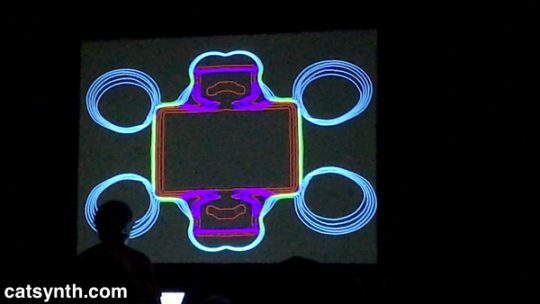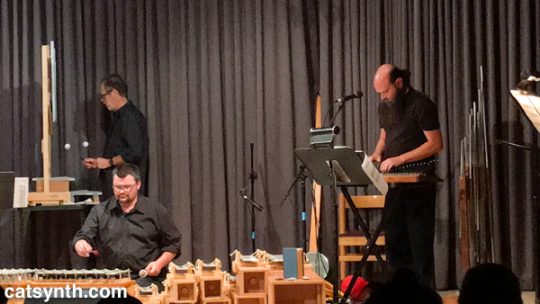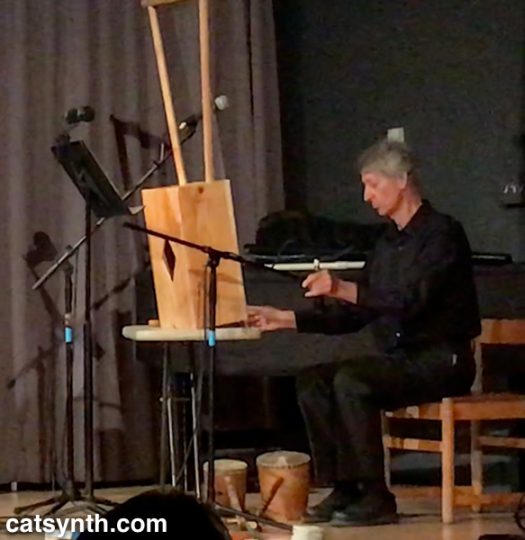Today we review the Music of Invention: A Concert Celebrating Tom Nunn’s Inventions which recently took place the Community Music Center in San Francisco. This retrospective concert brought together not only many of Tom Nunn’s musical inventions from the past decades, but many of his closest musical collaborators as well. The evening was divided into several miniature sets, some with established ensembles as well as individual collaborations. Most of the names on the program were quite familiar, and I recalled from my interview with Nunn his describing the “master players” he has been fortunate to work with over the years.

[Bart Hopkin and Tom Nunn. Photo: PeterBKaars.com.]
The concert opened with a “inventors’ duo” as Tom Nunn performed alongside music-instrument maker Bart Hopkin. The first sounds were scratchy and metallic, primarily from Nunn’s instrument, the crab. Hopkin’s instrumental performance started out quite percussive as well but soon settled into a more tonal marimba-like state, albeit a tonality with an odd scale. The crab seemed to have two types of sound and texture that reflected the different types of rods, one louder and more metallic, and another more quick and watery. They settled into a pattern with quick rhythmic textures from the watery sounds and bass notes, with a steady rhythm forming and then breaking apart and then forming again. Hopkin switched to one of his other instruments, the ‘Moe, a clarinet-like instrument with a continuous pitch control. Although the sound was unmistakably that of a clarinet, the rapid pitch bends sometimes made it sound more like an analog synthesizer (with a square wave, of course). Against this, Nunn generated a musical “waterfall” from the crab that concluded with a harp-like arpeggio.

[Bart Hopikin on ‘Moe. Photo: PeterBKaars.com.]
This was followed by a performance of Allan Crossman‘s piece Plasticity. This was one of the only fully composed pieces on the program (the other being Skatchbox Blues). Originally for Sonoglyph and orchestra, on this occasion it was reduced to Sonoglyph performed by Nunn and piano performed by Crossman. The music began with metallic watery sounds from the Sonoglyph and anxious harmonies on the piano. The overall effect was quite dreamlike, and I had the impression throughout the piece of being a well-crafted children’s movie with a richly detailed imaginary world. The instrumental sounds ranged from resonant and chime-like to more scratchy and noisy. There were sections with traditional contrapuntal textures, humorous phrases, and even something that brought to mind a march or procession.
The next set featured the Octatonic T-Rodimba, a pitched instrument tuned to three separate octatonic scales. Nunn was joined for this set by guitarists Gary Knowlton and Michael Knowlton. From the start, it was a clash of timbres between the guitars and the T-Rodimba, with slow chords against fast runs. Over time, the guitars became more melodic and all three performers settled into a jazz-like feel. The rhythms were all separate at first, with scratchy guitar sounds providing percussion, but coalesced into a single unit with repeated phrases. Certainly, the octatonic scales were part of the music, but not a distinct part to be heard separately. With the rhythms aligned, the tonalities of the different instruments blended together. The music became louder and more percussive before concluding with a guitar drone and effects from the green Line 6 pedal many of us know and love.


[Tom Nunn on Lukie Tubes and Paul Winstanley on prepared bass. Photos: PeterBKaars.com.]
The following set introduced the Lukie Tubes, an instrument with a resonant metal plate suspended on balloons that excited using a series of cardboard tubes. Nunn was joined by Paul Winstanley performing on “prepared electric bass”. He performed by bowing on the bass, which had several rods inserted between the strings and the neck for a variety of sounds that were enhanced by additional electronic effects. The bass blended will with the Lukie Tubes as the set began with a long metallic drone on both instruments with different resonances coming in and out of focus. The overall effect was a lush but eerie landscape, punctuated with bits of static and shorter tones. The were moments that brought to mind whales and others reminiscent of Central Asian throat singing. In addition to the acoustic strength of Lukie Tubes, Winstanley used another Line 6 pedal to build up energy. The loud sounds gave way to softer higher tones and then a quiet but more percussive conclusion.

[RTD3. Photo: PeterBKaars.com.]
The final set of the first half featured RTD3, a trio of Ron Heglin, Tom Nunn and Doug Caroll. I have heard RTD3 on several occasions in the past. For this performance, Caroll was on cello as usual, Heglin was performing only on voice (i.e., no trombone), and Tom Nunn was on Skatchbox. In particular, this was the debut of one of the “perfect” Skatchboxes that I had seen during the interview. Musically, things start of softly with voice a percussive cello. Heglin’s vocals featured a wide variety of effects, groans, gurgles and rumbles, along with incantations on unknown (and perhaps unknowable) words. The vocals filled the space in between the cello and the distinctive comb noises of the Skatchbox. Nunn switched to Lukie tubes during the performance, and then to another instrument called the Techphonic plate. During this time Caroll’s cello performance moved from traditional practice (pitched bowed tones) to more plucking and percussive techniques, and finally to extended techniques such as using a cork on the strings and scratching on the back of the instrument. All three performs came together for a final drone that ended with a minor modal harmony.
The second half opened with a live performance of “Skatchbox Blues”, which was released as a single in conjunction with the concert. It was a lighthearted departure from the other sets with a traditional “country blues” feel provided by Gary Knowlton and Michael Knowlton on guitars, and Aurora Josephson on voice. The Skatchbox itself as played by David Michalak was a purely percussion instrument in the context of this piece, with the grinding and buzzing sounds working together with the guitar to provide the familiar traditional rhythm. The lyrics were a humorous send-off of the experience of building and playing a Skatchbox, with the repeated cadence “treasures in the trash.”

[Skatchbox Blues. Photo: PeterBKaars.com.]
The next set featured Ed Herrmann on the Octatonic T-Rodimba with Nun on the Crab. Here, the tonality and timbre of the T-Rodimba was used to full effect, with Hermann performing rhythmic phrases and switching among different types of mallets. Between the two metal instruments and rhythmic texture, this set was particularly “gamelan-like”, with call-and-response between the two performers and moments of synchronicity. There were moments of slower movement and empty space as well. During the set, I heard something from hall which I dubbed at the time “unexplained bass”, a series disembodied low bowed tones. It turns out the Doug Caroll was had quietly slipped into the audience with his cello and joined into the mix. The acoustics of the hall helped to give his addition a more surprising and disorienting quality. But overall, it did add a supporting quality to the music and a contrast to the more metallic sounds. The overall effect reminded me quite a bit of the music of Harry Parch.

[Rent Romus and Tom Nunn. Photo: PeterBKaars.com.]
TD Skatchit, the Skatchbox duo of Tom Nunn and David Michalak, made its official appearance with a pair of mini-sets, each with a guest soloist. The first featured Rent Romus on saxophones. The result was a delightfully noisy set the requisite squeaks, squaws and other effects, punctuated by more jazz-like tonal phrases. Nunn and Michalak provided a rhythm trading notes on the Skatchboxes. The tones were more of the continuous scratches and rumbles, but after a grand pause, Nunn produced a more rhythmic sound from one element of his Skatchbox with a repeated beat that reminded me a bit of rumble strips. The music gradually grew louder, with more complex and intricate jazz runs. Ultimately, Romus pulled out both an alto and soprano sax to play simultaneously in a loud and intense final run.

[Aurora Josephson with TD Skatchit. Photo: PeterBKaars.com.]
Aurora Josephson returned to perform in the second set with TD Skatchit. It was clear from the start that this was going to be different from her traditional blues vocals only a few minutes earlier, as she took a large swig of water from a bottle and began to vocalize with subtle squeaks and wiggles as well as louder gurgles. Her percussive sounds blended well with the Skatchboxes, which responded with squeakier timbres. The performance was visually and aurally quite humorous and small bursts of laughter could be heard from the audience – to me, this seemed perfectly appropriate and acceptable for such a performance. At times, she seemed to be a third percussion instrument as she traded short notes with Nunn and Michalak. There were a few messy (i.e., wet) moments, but Josephson reminded us, “It’s just water.”

[Ghost in the House. Photo: PeterBKaars.com.]
The final performance featured Ghost in the House, with Nunn and Michalak joined by regular group members Karen Stackpole on metal percussion and John Ingle on saxophone, and guest Bart Hopkin. Like RTD3, I have seen Ghost in the House a few times before. This time they did not do their usual ritualistic procession into the hall, probably because of the logistics involved, but they appeared on stage bathed in eerie blue light punctuated by candles. The opening sounds were quite resonant and featured rich harmonics. Nunn’s instrument, the Crustacean, blends quite well with Karen Stackpole’s gongs, and a rhythm emerged in the beating patterns between the instrument. Layered in between was Michalak’s lap-steel guitar, which always seems to have a melancholy sound. Bart Hopkin’s instrument, called the Disorderly Tumbling, provided a cascade of high bell sounds that lingered above the other timbres. In a performance like this I find myself listening for the details such as these. Others that caught my attention in this section of the performance were Stackpole’s row of keys, Ingle’s swelling saxophone town, and intense sound of the bowed Crustacean. Over time, the texture became more sparse and glitchy, including mouthpiece noises on the saxophone, striking of metal bowls, and short notes on the Techphonic plate. The music then moved into an eerie phase with lap steel drones, toy-like sounds and the Lukie tubes that reminded me of an old radio or classic science fiction soundtrack. The tones became richer and darker, with long tones and wiggling metal sheets, saxophone multiphonics and glissandi; and finally more rhythmic, with bouncing high tones and the cascading bells, matched by saxophone and gong.


[Karen Stackpole and Tom Nunn. Photos: PeterBKaars.com.]
The concert was well received, and there was quite a long moment of mutual appreciation between Tom Nunn and the audience. This was clearly a special occasion for him, for the musicians and those in attendance. There was also a warm recognition of David Michalak, who was primarily responsible for proposing this concert and making it happen as well as it did. It was quite a logistical feat to have so many sets with large and unusual instruments.
We conclude with what I believe is the smallest invention of the evening. Nunn had made several limited-edition mini-Skatchboxes to commemorate the evening. One of them went home with me and waits to be used in a future musical project inspired by what I heard at this concert.



















